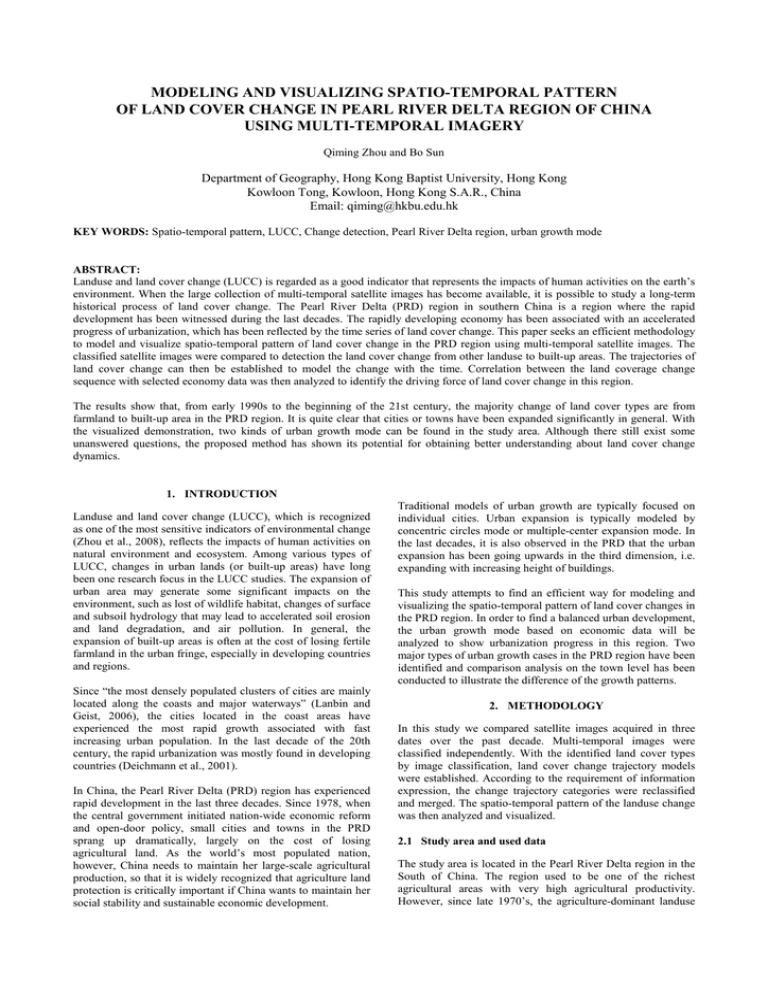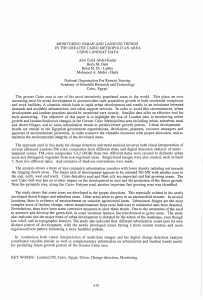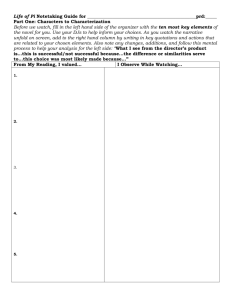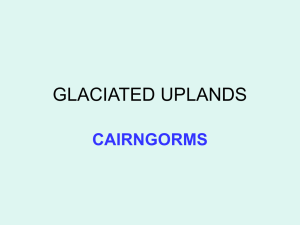MODELING AND VISUALIZING SPATIO-TEMPORAL PATTERN
advertisement

MODELING AND VISUALIZING SPATIO-TEMPORAL PATTERN OF LAND COVER CHANGE IN PEARL RIVER DELTA REGION OF CHINA USING MULTI-TEMPORAL IMAGERY Qiming Zhou and Bo Sun Department of Geography, Hong Kong Baptist University, Hong Kong Kowloon Tong, Kowloon, Hong Kong S.A.R., China Email: qiming@hkbu.edu.hk KEY WORDS: Spatio-temporal pattern, LUCC, Change detection, Pearl River Delta region, urban growth mode ABSTRACT: Landuse and land cover change (LUCC) is regarded as a good indicator that represents the impacts of human activities on the earth’s environment. When the large collection of multi-temporal satellite images has become available, it is possible to study a long-term historical process of land cover change. The Pearl River Delta (PRD) region in southern China is a region where the rapid development has been witnessed during the last decades. The rapidly developing economy has been associated with an accelerated progress of urbanization, which has been reflected by the time series of land cover change. This paper seeks an efficient methodology to model and visualize spatio-temporal pattern of land cover change in the PRD region using multi-temporal satellite images. The classified satellite images were compared to detection the land cover change from other landuse to built-up areas. The trajectories of land cover change can then be established to model the change with the time. Correlation between the land coverage change sequence with selected economy data was then analyzed to identify the driving force of land cover change in this region. The results show that, from early 1990s to the beginning of the 21st century, the majority change of land cover types are from farmland to built-up area in the PRD region. It is quite clear that cities or towns have been expanded significantly in general. With the visualized demonstration, two kinds of urban growth mode can be found in the study area. Although there still exist some unanswered questions, the proposed method has shown its potential for obtaining better understanding about land cover change dynamics. 1. INTRODUCTION Landuse and land cover change (LUCC), which is recognized as one of the most sensitive indicators of environmental change (Zhou et al., 2008), reflects the impacts of human activities on natural environment and ecosystem. Among various types of LUCC, changes in urban lands (or built-up areas) have long been one research focus in the LUCC studies. The expansion of urban area may generate some significant impacts on the environment, such as lost of wildlife habitat, changes of surface and subsoil hydrology that may lead to accelerated soil erosion and land degradation, and air pollution. In general, the expansion of built-up areas is often at the cost of losing fertile farmland in the urban fringe, especially in developing countries and regions. Since “the most densely populated clusters of cities are mainly located along the coasts and major waterways” (Lanbin and Geist, 2006), the cities located in the coast areas have experienced the most rapid growth associated with fast increasing urban population. In the last decade of the 20th century, the rapid urbanization was mostly found in developing countries (Deichmann et al., 2001). In China, the Pearl River Delta (PRD) region has experienced rapid development in the last three decades. Since 1978, when the central government initiated nation-wide economic reform and open-door policy, small cities and towns in the PRD sprang up dramatically, largely on the cost of losing agricultural land. As the world’s most populated nation, however, China needs to maintain her large-scale agricultural production, so that it is widely recognized that agriculture land protection is critically important if China wants to maintain her social stability and sustainable economic development. Traditional models of urban growth are typically focused on individual cities. Urban expansion is typically modeled by concentric circles mode or multiple-center expansion mode. In the last decades, it is also observed in the PRD that the urban expansion has been going upwards in the third dimension, i.e. expanding with increasing height of buildings. This study attempts to find an efficient way for modeling and visualizing the spatio-temporal pattern of land cover changes in the PRD region. In order to find a balanced urban development, the urban growth mode based on economic data will be analyzed to show urbanization progress in this region. Two major types of urban growth cases in the PRD region have been identified and comparison analysis on the town level has been conducted to illustrate the difference of the growth patterns. 2. METHODOLOGY In this study we compared satellite images acquired in three dates over the past decade. Multi-temporal images were classified independently. With the identified land cover types by image classification, land cover change trajectory models were established. According to the requirement of information expression, the change trajectory categories were reclassified and merged. The spatio-temporal pattern of the landuse change was then analyzed and visualized. 2.1 Study area and used data The study area is located in the Pearl River Delta region in the South of China. The region used to be one of the richest agricultural areas with very high agricultural productivity. However, since late 1970’s, the agriculture-dominant landuse has given the way to urban built-up area landuse, with large proportion of agricultural land transferred to urban built-up area. In order to retrieve change dynamics, a time series of Landsat TM/ETM+ images has been established. A full coverage of the PRD region needs a mosaic of several scenes of imagery, which may have to be acquired in dates up to one year apart, due to the high probability of cloud cover. We therefore identify three focused years, which are named as circa determined by the acquisition date of the dominant scenes. The images captured at the same season in previous or following year are used to produce image mosaics. Because of covering with heavy clouds in the mosaic images, three counties of the PRD region are excluded from the analysis. The following table lists the images used for this study. Table 1 List of Landsat images used for the whole study area. Circa year PathAcquisition Sensor Row date 121-44 09-10-1991 TM *122-44 21-12-1992 TM 1992 *122-45 21-12-1992 TM 123-44 21-9-1991 TM 123-45 02-9-1991 TM 121-44 10-1-1997 TM *122-44 22-12-1998 TM 1998 *122-45 22-12-1998 TM 123-44 24-12-1999 ETM+ 123-45 24-12-1999 ETM+ 121-44 31-12-2001 ETM+ *122-44 20-11-2001 ETM+ 2001 *122-45 20-11-2001 ETM+ 123-44 29-12-2001 ETM+ 123-45 29-12-2001 ETM+ * The domination scenes of each circa year Resolution (m) 30.0 28.5 28.5 28.5 28.5 30.0 30.0 30.0 28.5 28.5 30.0 30.0 30.0 30.0 30.0 In order to study more details of the rapid urban expansion process, higher frequency of observation on land cover change is needed. Dongguan City is therefore selected as the experimental region for more detailed study. Five Landsat images (Path-Row: 122-44) with approximate two-year time intervals are used for this region to detect land cover changes from 1992 to 2001. The images are listed as follows. Table 2 List of Landsat images used for Dongguan City. Acquisition date 21-12-1992 24-10-1994 03-3-1996 22-12-1998 20-12-2001 Sensor TM TM TM TM ETM+ Resolution (m) 28.5 30.0 28.5 30.0 30.0 A well-constructed geo-referenced database (HK SAR Planning Department, 2003) is available for this study. All acquired images are rectified and geo-coded using image-to-map registration before being used to produce image mosaic. Spatial registration errors have been controlled within 0.5 pixels. In order to make images comparable, all images have been resampled to the same spatial resolution. 2.2 Image classification Considering multi-temporal images are acquired at different time, the post-classification comparison method is widely employed for minimizing seasonal impacts or radiometric calibration problems (Coppin et al., 2004). For this study, a supervised classification by Maximum Likelihood Classifier (MLC) is used in this procedure. Images are independently classified into several classes. Referring to Wu’s (1994) landuse and cover classification system of China, classes are then merged into five land cover types including agricultural land, woodland/grass, water body, urban area and others (bare ground or unclassified). Due to the difficulty of getting historical ground truth data for reference, a random sampling test for classification accuracy assessment is employed. The sampling points are interpreted manually on the original images. Confusion matrix is produced as the result of accuracy assessment. 2.3 Spatio-temporal modeling of land cover change The traditional temporal analysis is based on a time series of indices, for example, the NDVI index or area statistics. It tells from when a change happened but it does not tell spatial information like where the change occurred. In order to establish a spatio-temporal model for better description of the land cover change and to analyze the change pattern, change trajectories are established on the basis of the classified images (Zhou et al., 2008a, 2008b). This trajectory is based on pixellevel comparison. A change trajectory can be specified as “Woodland-Farmland-Urban”, meaning that the land was once cultivated from woodland and then transferred to urban landuse. This process can be represented by unique coding as “W-F-U”. All classified images are integrated into ArcGIS with the raster format. 2.4 Visualization of change trajectories To better visualize the land cover changes, some change trajectories of interest were highlighted using the above notation of identified change trajectories. 3. RESULTS AND ANALYSIS 3.1 Land cover change at the region level About 700 random samples of ground reference points were selected on each circa of image. As Table 3 shows, accuracy assessment based on five target classes has shown an acceptable accuracy result. Table 3 Accuracy assessment of image classification at the region level. Circa Overall accuracy (%) Kappa coefficient 1992 1998 2001 90.8 90.3 90.0 0.88 0.87 0.86 Since urbanization is the major driving force of land cover changes in the PRD region in the last 30 years, the expansion of the built-up area has been highlighted to represent this progress from 1992 to 2001. Figure 1 shows the result of visualizing the spatio-temporal land cover change in the whole region in terms of rapid urbanization progress. Table 4 lists the interested trajectories of land cover change. Considering that once a land cover was labeled as built-up area, it will seldom change to other land cover types. Thus the when an unlikely change trajectory occurs in the analytical result, it is defined as an error case (Liu and Zhou 2004, Li and Zhou 2009). From Table 4, the area of urban has increased by 306,000 ha during the nine-year period, with an average growth rate of 19.2% per annum. Two major trajectory errors were also identified. Those error trajectories are both caused by misclassification of images, Type 1 error trajectories are mainly found around several locations, where heavy cloud cover or some unusual incidences (e.g. smoke from forest fire) caused the mis-classification in the image of circa 1992. The image classification accuracy nevertheless is acceptable for this study. Table 4 Change trajectories of interest in the PRD region. Trajectory U-U-U O-U-U O-O-U Description Old urban Built-up area since 1992 Built-up area since 1998 Area (ha) 79,210 142,570 % 2.35 4.23 163,550 4.85 U-O-U Error trajectories 20,960 0.62 (Type1) U-U-O Error trajectories 7,110 0.21 (Type2) Where U = Urban and O = Others (the other land cover types); the order of trajectories is from 1992 to 2001 Figure 1 Spatio-temporal change trajectories (urban expansion highlighted) in the PRD region from 1992 to 2001. 3.2 Urbanization progress at the town level At the town level, classifications also achieved overall accuracies above 90% with kappa greater than 0.9. As Table 5 shows, the classification accuracy at the town level is acceptable. Table 5 Accuracy assessment of image classification at the town level. Year Overall accuracy (%) Kappa coefficient 1992 92.1 0.89 1994 95.0 0.93 1996 97.4 0.96 1998 96.1 0.95 2001 98.1 0.97 In a town level analysis, the study on the spatial pattern of urban expansion was undertaken. Figure 2 shows the urbanization progress in Dongguan City. The built-up area has been expanded around the existing main town centres, while new built-up areas show a tendency to distribute along the highways in the countryside. 5. CONCLUSION This study has demonstrated a trajectory-based approach for land cover change detection and visualization of change dynamics in the PRD region. Due to the rapid land cover changes in urbanization and increased population, serious environmental problems may occur if the urban expansion has no restriction. The proposed approach does not only monitor the progress of urbanization in temporal view but also visualize the location and trend of changes in spatial view. The analytical result of this study shows that the urbanization is the main driving force of land cover change in the PRD region. During the study period, built-up areas have largely expanded by converting land from other land cover types. Through mapping highlighted urban expansion trajectories, two major modes of urban growth can be well visualized. The newly developed towns have a tendency to expand their areas from the rural landuse, while the development of old cities is more likely to grow through improving their landuse efficiency. Figure 2 Urban expansions in Dongguan City. 4. DISCUSSION In this study, multi-temporal images have been acquired at different time with various situations. This fact will take its toll in detecting land cover changes. A high accurate detection of land cover changes can benefit from the adoption of postclassification comparison method, by which images are classified independently. The independent classification has minimized the problems of radiometric calibration among images of different dates. We can also check some image classification errors by using this method for change detection. As Table 4 did, trajectory rationality may help to detect classification errors in image classification processing. It has been indicated that post-classification comparison method may overestimate land cover changes (Vanoort, 2005) and the accuracy of change detection is very sensitive to the accuracy of image classification. Although one can argue that the impact of classification may be minimized by better classification results, it has been proven that the combined accuracy will be lower when analyzing more layers together (Congalton and Green, 1999). Comparing with the well-developed cities like Guangzhou, Hong Kong, Dongguan City is a newly developed town. In the early stage of economic growth, the growth is more likely sourced by the acquisition of valuable land, on the cost of lost of farmland. Industrialization obviously needs more land to host the factories, warehouses, markets, and so on, which are often started along river or major transportation lines. On the other hand, well-developed cities tend to improve their landuse efficiency to cope with economic and population growth (Shen, et al., 2006; Hou, 2008; Zhou and Hou 2008). In this situation, urban growth of area may be not too obvious. In order to see more detailed spatial patterns of the land cover change in this region, quantified indices can be introduced in this study for measure city structures or farmland distributed patterns in the progress of land cover change. ACKNOWLEDGEMENT The research is supported by National Key Basic Research and Development Program (2006CB701304), Research Grants Council Competitive Earmarked Research Grant (HKBU 2029/07P), and Hong Kong Baptist University Faculty Research Grant (FRG/06-07/II-76). REFERENCES Congalton, R.G. and Green, K., 1999. Assessing the accuracy of remotely sensed data (2nd edition). Boca Raton: CRC Press. Coppin, P., Jonckheere, I., Nackaerts, K., Muys, B. and Lambin, 2004. Digital change detection methods in ecosystem monitoring: a review. International Journal of Remote Sensing, 25(9), pp. 1565–1596. Deichmann, U., Balk, D. and Yetman, G., 2001. Transforming population data for interdisciplinary usages: from census to grid. New York: CIESIN. HK SAR Planning Department, 2003. Hong Kong 2030: Planning vision and strategy consultancy study to analyse broad landuse pattern of the Pearl River Delta Region, [Report]. Hou, Q., 2008. Spatio-temporal relationships between urban growth and economic development in the Pearl River Delta region of China. [Mphil Thesis] in Hong Kong Baptist University. Lambin, E.F. and Geist, H.J., 2006. Landuse and land cover change local processes and global impacts. Berlin: Springer. Li, B. and Zhou, Q., (2009). Accuracy assessment on multitemporal land cover change detection using a trajectory error matrix, International Journal of Remote Sensing, 30(5), pp. 1283-1296. Liu, H. and Zhou, Q., 2004. Accuracy analysis of remote sensing change detection by rule-based rationality evaluation with post-classification comparison. International Journal of Remote Sensing, 25(5), pp. 1037–1050. Shen, J., Feng, Z. and Wong K., 2006. Dual-track urbanization in a transitional economy: The case of Pearl River Delta in South China. Habitat International, (30), pp. 690-705. Vanoort, P. A. J., 2005. Improving land cover change estimates by accounting for classification errors. International Journal of Remote Sensing, 26(14), pp. 3009-3024. Wu, Q. and Guo, H., 1994. Landuse in China (in Chinese). Beijing: Science Press. Zhou, Q. and Hou, Q., 2009. The broad landuse pattern and landuse change in the last two decades, in Wong, K.K. (ed.), Hong Kong, Macau and the Pearl River Delta: A Geographical Survey, Hong Kong Educational Publishing Co., Hong Kong, pp. 68-98. Zhou, Q., Li, B. and Kurban, A., 2008a. Trajectory analysis of land cover change in arid environment of China, International Journal of Remote Sensing, 29(4), pp. 1093-1107. Zhou, Q., Li, B. and Kurban, A., 2008b. Spatial pattern analysis of land cover change trajectories in Tarim Basin, northwest China, International Journal of Remote Sensing, 29(19), pp. 5495-5509.




